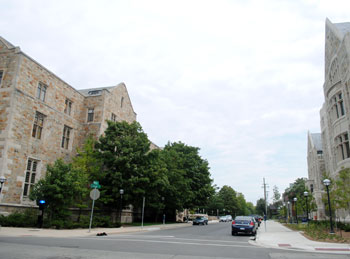Column: Ann Arbor’s Monroe (Street) Doctrine
On the northeast corner at the intersection of State and Hill streets in Ann Arbor, the University of Michigan’s Weill Hall stands majestically as a landmark building, establishing the southwest corner of the UM campus.

Looking east down Monroe Street, across State Street. This section of Monroe Street is flanked by two University of Michigan law school buildings: Hutchins Hall to the north, and South Hall. (Photos by the writer. )
Following State Street north up the hill towards downtown will lead you to the intersection with Monroe Street. Turn right on Monroe, and you’ll wind up at Dominick’s, a local watering hole, majestic in its own right.
One parking option for patrons of Dominick’s is that first block of Monroe Street east of State. And what better topic to discuss over a pitcher of beer, sitting at a Dominick’s picnic table, than Ann Arbor parking rates. How much should it cost to use an on-street parking space on Monroe in that one block between State and Oakland?
Here’s a different question: How much for the whole damn block? I don’t mean just the parking spaces. I mean the whole right-of-way.
That question is part of a current conversation among public officials from the city of Ann Arbor and the University of Michigan. The university is not interested in parking cars on that block. In fact, it’s the university’s desire that the thoroughfare be blocked to vehicular traffic. Permanently.
By tackling this topic, I’d like to achieve a two-fold purpose. First, I’d like to promote the daylighting of conversations now taking place out of public view. Second, I’d like to provide a rational way to approach calculating the value of city right-of-way, specifically in the general context of city-university relations.
Otherwise put, I’d like to sketch out a kind of Monroe Doctrine for Ann Arbor, which might in some ways mirror the message in the original Monroe Doctrine, set forth by President James Monroe in his address to Congress, on Dec. 2, 1823.
I’m not going to suggest including the part that talks about when “our rights are invaded or seriously menaced …” [Full Story]



